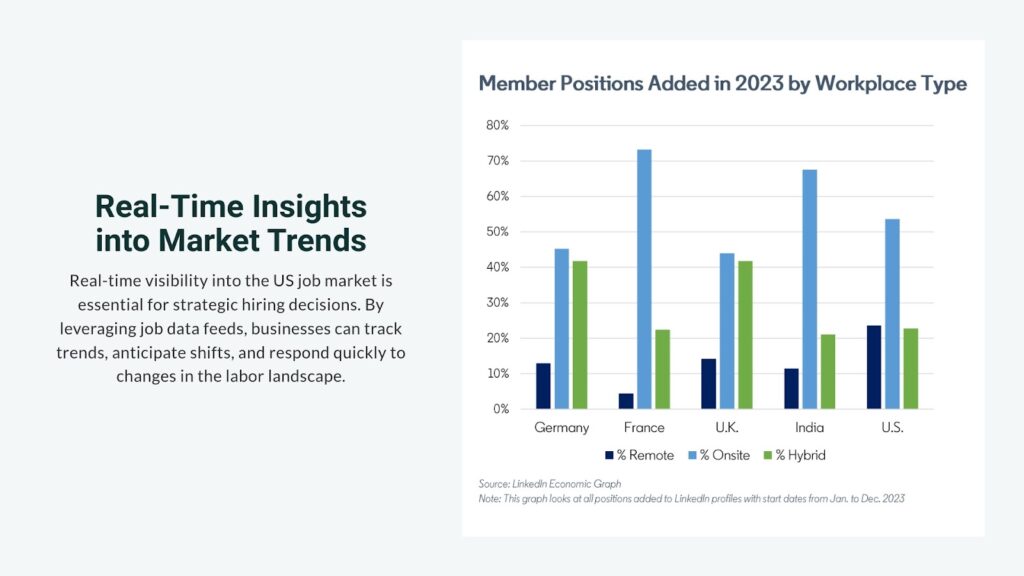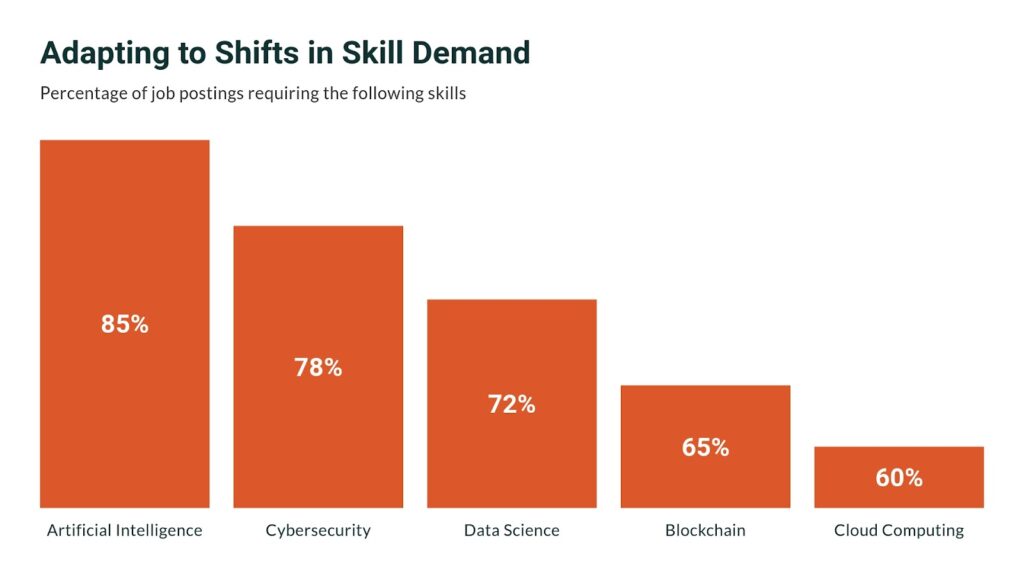In today’s dynamic economy, understanding the intricacies of the US job market is critical for recruiters and businesses. With real-time access to job data feeds, organizations can gain the insights they need to make more informed hiring and business decisions. By tapping into these data feeds, consulting firms and recruiters can track trends in the US tech job market and anticipate shifts, allowing them to respond quickly and effectively. In this guide, we’ll explore how leveraging job data feeds provides real-time visibility into the current job market in the US, while offering strategies to navigate the complexities of the US tech job market in 2024.
What is Job Data Feeds?
Job data feeds provide structured and up-to-date information on job listings, including details like job titles, locations, required skills, compensation, and company details. These feeds aggregate data from multiple sources—such as job boards, company websites, and government databases—offering recruiters and businesses an accurate view of the current job market in the US.
For consulting firms, job data feeds serve as a critical tool for analyzing hiring trends, identifying skill gaps, and benchmarking against competitors. In an environment where rapid changes in the US tech job market can significantly impact talent acquisition strategies, real-time data helps businesses remain agile and competitive.
How Job Data Feeds Add Value to the US Job Market?
The US job market is highly competitive, with constant fluctuations in job demand, talent availability, and market conditions. Job data feeds offer several benefits to businesses and recruiters trying to navigate these complexities.
1. Real-Time Insights into Market Trends
Understanding how the current job market in the US is evolving in real-time is essential for making strategic hiring decisions. Job data feeds provide continuous updates on job postings across industries, giving consulting firms and businesses the ability to track market trends as they happen. This is particularly valuable in the US tech job market, where demand for specific skills like cloud computing, AI, and cybersecurity can shift rapidly.
For example, in 2024, the US tech job market is expected to see continued demand for software developers, data scientists, and cybersecurity experts. Job data feeds can reveal which companies are hiring for these roles, where the demand is highest geographically, and what salary ranges are being offered.

2. Competitor Analysis
Job data feeds also allow businesses to conduct detailed competitor analysis. By monitoring competitors’ job postings, companies can assess the skills their rivals are seeking, the roles they are prioritizing, and the regions they are expanding into. This provides crucial intelligence on how to adjust hiring strategies to stay ahead in the competitive US tech job market.
For instance, if a consulting firm sees that competitors are aggressively hiring in emerging fields like blockchain technology or machine learning, they can proactively adjust their recruitment strategy to ensure they are not left behind.
3. Identifying Emerging Job Roles and Skill Sets
The US job market is constantly evolving, with new job roles and required skills emerging as industries innovate and adapt to technological changes. Job data feeds help businesses stay informed about these developments, particularly in the US tech job market, where rapid advancements often create new job categories.
For instance, in 2024, the US tech job market may see growth in roles related to AI ethics, quantum computing, or 5G technology. Job data feeds allow businesses to spot these trends early, ensuring they can attract talent with the right skill sets before competitors do.
How to Leverage Job Data Feeds for Success in the US Tech Job Market?
The US tech job market presents both opportunities and challenges for businesses and recruiters. As tech continues to drive innovation across industries, the competition for top talent is fierce. Navigating this landscape requires leveraging job data feeds to understand hiring patterns, skill demand, and geographical trends.
1. Tracking Regional Job Market Trends
Different regions across the US have varying levels of demand for tech talent. Job data feeds allow businesses to analyze geographic trends in the US tech job market, helping them focus recruitment efforts where talent is most needed and where demand is highest.
For instance, cities like San Francisco, Austin, and New York have traditionally been hotspots for tech jobs. However, as remote work becomes more widespread, demand for tech talent is expanding into new regions. States like Colorado, Utah, and North Carolina are seeing increased activity in the tech sector. By leveraging job data feeds, recruiters can identify these emerging regions and target candidates accordingly.
2. Adapting to Shifts in Skill Demand

The US tech job market is known for its rapid shifts in skill demand. Technologies that were in high demand two years ago may now be eclipsed by newer, cutting-edge technologies. For example, cloud computing skills have been critical over the last decade, but today, AI and machine learning expertise are becoming increasingly essential.
Job data feeds provide a way for recruiters to stay ahead of these shifts. By tracking job postings that specify desired skills, businesses can identify emerging skill sets and ensure they are hiring for the roles that will be most valuable in the future. In 2024, the US tech job market is likely to emphasize skills in areas like AI, data science, and blockchain.
Consulting firms can use this information to adjust their hiring strategies, ensuring they are acquiring the talent needed to meet future client demands.
3. Optimizing Job Advertisements
To successfully attract talent in a competitive market, businesses must optimize their job advertisements to stand out. Job data feeds provide Job insights into the language, tone, and format that competitors use in their job postings. By analyzing these details, companies can refine their own job ads to better resonate with potential candidates.
For example, if job data feeds show that competitors are highlighting flexible work arrangements and remote work options, businesses can adapt their job postings to emphasize similar benefits. This is especially important in the US tech job market, where top candidates often have multiple offers and prioritize companies that offer work-life balance, career development, and innovation.
4. Predicting Future Job Market Trends
One of the key advantages of leveraging job data feeds is the ability to predict future trends in the US job market. Predictive analytics, based on historical and real-time job data, can forecast which industries or regions will see job growth and which skills will be most in demand.
For consulting firms, this information is invaluable for advising clients on future workforce needs. If the US tech job market in 2024 is expected to experience significant growth in areas like cybersecurity, firms can guide clients to focus on hiring cybersecurity professionals to ensure they remain competitive.
How to Integrate Job Data Feeds into Recruitment Strategies?
Now that we’ve explored the value of job data feeds in the US job market, let’s discuss how businesses and recruiters can integrate these data feeds into their recruitment strategies.
1. Choosing the Right Job Data Feed Provider
To leverage job data feeds effectively, businesses need to select a provider that offers comprehensive and up-to-date data. It’s important to choose a provider that covers a wide range of industries and job types, especially in the US tech job market, where data accuracy and granularity are critical for decision-making.
Look for job data feed providers that offer real-time updates, customizable data points, and integration with existing recruitment platforms. This ensures that recruiters have access to the most relevant and actionable data.
2. Incorporating Data into Workforce Planning
Job data feeds are not just useful for immediate hiring needs—they can also play a vital role in long-term workforce planning. By analyzing job data over time, businesses can identify trends that inform strategic decisions about talent acquisition, training, and development.
For instance, if job data feeds indicate that demand for certain tech skills is expected to grow significantly over the next few years, businesses can proactively upskill existing employees or develop talent pipelines to meet future needs.
3. Using Job Data Feeds for Competitive Benchmarking
As mentioned earlier, job data feeds allow for detailed competitor analysis. By monitoring how competitors are hiring and what skills they are prioritizing, businesses can benchmark their own recruitment efforts and ensure they are competitive in the US tech job market.
For example, if data shows that competitors are offering higher salaries or better benefits for in-demand roles like software engineers or data analysts, businesses can adjust their compensation packages to attract top talent.
4. Integrating Job Data Feeds with ATS and CRM Systems
For maximum efficiency, businesses should integrate job data feeds with their applicant tracking systems (ATS) and customer relationship management (CRM) platforms. This allows recruiters to automate the process of analyzing job market data and use it to inform real-time decisions.
An integrated system can automatically flag trends in the US job market and alert recruiters to shifts in skill demand, helping them make quicker, more informed decisions about hiring.
Conclusion
The US job market is complex, constantly shifting, and highly competitive. For recruiters and consulting firms, leveraging job data feeds offers a powerful way to gain real-time insights into market trends, understand competitor hiring strategies, and predict future shifts in demand. In the rapidly changing US tech job market of 2024, staying ahead of the curve requires not only monitoring the market but also adapting quickly to its changes.
With the right job data feeds, businesses can enhance their recruitment strategies, optimize their job postings, and make more informed decisions about workforce planning. Whether you’re navigating the challenges of the current job market in the US or preparing for future opportunities in the US tech job market, job data feeds provide the intelligence needed to stay competitive.
To access real-time job market insights, sign up with Jobspikr and start harnessing the power of job data feeds today.



